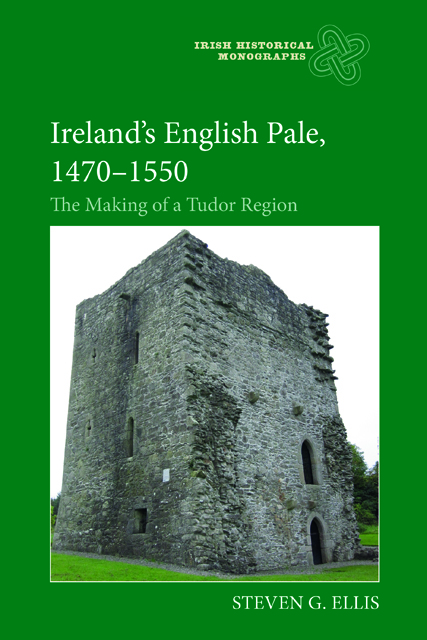Book contents
- Frontmatter
- Contents
- List of Maps
- Preface
- List of Abbreviations
- Introduction: in search of Ireland's English Pale
- 1 The horizons of English rule: retreat and recovery
- 2 The fortifications and identity of a military frontier
- 3 County Dublin and the military frontier
- 4 Strengthening the march in County Kildare
- 5 The English Pale's westward expansion: County Meath
- 6 The English Pale's northern frontier: County Louth
- 7 Restoring the English Pale, 1534-41
- 8 The waning of the English Pale
- Conclusion: an English region in Tudor Ireland
- Bibliography
- Index
- Irish Historical Monographs previous volumes
3 - County Dublin and the military frontier
Published online by Cambridge University Press: 09 January 2024
- Frontmatter
- Contents
- List of Maps
- Preface
- List of Abbreviations
- Introduction: in search of Ireland's English Pale
- 1 The horizons of English rule: retreat and recovery
- 2 The fortifications and identity of a military frontier
- 3 County Dublin and the military frontier
- 4 Strengthening the march in County Kildare
- 5 The English Pale's westward expansion: County Meath
- 6 The English Pale's northern frontier: County Louth
- 7 Restoring the English Pale, 1534-41
- 8 The waning of the English Pale
- Conclusion: an English region in Tudor Ireland
- Bibliography
- Index
- Irish Historical Monographs previous volumes
Summary
The rule and defence of the south Dublin area had long been a priority for the Irish administration, and the origins of the frontier there reflected the region’s topography and settlement patterns, with medieval English settlement focused on the arable lowlands of the eastern coastal plain. Native Irish chieftaincies, the O’Byrnes, the O’Tooles, and the MacMurrough-Kavanaghs, were displaced into the surrounding uplands and Leinster mountains, leaving a series of marches which frequently followed the contours of the land or intersections between areas of different land capability. Initially, this frontier had consisted of little more than a legal distinction between lands now held by ‘the king’s loyal English lieges’ and the territory still occupied by ‘the king’s Irish enemies’; but, as pressure on the English settlers mounted in the 1290s, the exchequer stepped in to offer support. It began paying for a chain of wards, of a dozen men or so, around the northern, eastern, and western fringes of the mountains so as to consolidate English control and contain the Irish within this area. In the fourteenth century, we may talk about an organized frontier south of Dublin. Later, those places guarded around the mountain fringes in the 1350s often became strongpoints on the 1488 statutory march–maghery boundary running from Ballymore Eustace, through Rathmore, Kilteel, Saggart, and Tallaght. Likewise, along the east coast, the places guarded had included Bray, Balyteny, Newcastle McKynegan, and Wicklow, which were crucial for defence of the king’s highway from Dublin to Arklow; but this route had become impassable long before the O’Tooles reoccupied Balyteny and the O’Byrnes finally destroyed Newcastle McKynegan in 1405. By then, Wicklow town and castle had been reduced to an isolated English outpost as the O’Byrnes pushed back to the coast.
Formally, the English shire of Dublin included the whole area north of Wicklow in the east, and in the west from around Hollywood northwards. In between, however, a formidable barrier to east–west communication were the Leinster mountains, occupied by the king’s Irish enemies, the O’Tooles, the O’Byrnes, and the MacMurrough-Kavanaghs, who represented a significant military threat to English power in the region. In the early 1490s the O’Tooles could raise 24 horsemen and 80 kerne; the O’Byrnes 60 horsemen, 160 kerne and ‘a battayll gallowglas’ [c.80 galloglass]; and the MacMurrough-Kavanaghs to the south 200 horsemen, ‘a battaylle of galloglas’ and 300 kerne.
- Type
- Chapter
- Information
- Ireland's English Pale, 1470-1550The Making of a Tudor Region, pp. 59 - 76Publisher: Boydell & BrewerPrint publication year: 2021



